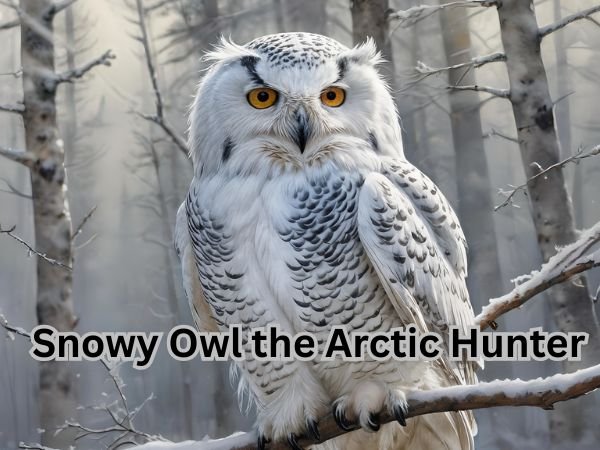
When people hear the phrase “Snowy Owl the Arctic Hunter,” two images often come to mind: First, the striking white owl gliding silently over frozen tundra, scanning the snow for its next meal. Second, the legendary predator whose survival skills have fascinated nature lovers and pet owners alike. The snowy owl, also known as the Arctic hunter, is a master of survival in one of the world’s harshest environments.
In this article, we’ll uncover the eight extraordinary traits that make the snowy owl a true Arctic hunter. Whether you’re a bird enthusiast, a curious pet owner, or simply captivated by wildlife, you’ll find actionable advice, expert insights, and fascinating facts to help you understand and appreciate this iconic species. Get ready to discover what sets the snowy owl apart—and why its story continues to inspire animal lovers around the world.
What Makes the Snowy Owl a Born Survivor? Snowy Owl the Arctic Hunter
The snowy owl, also called the Arctic owl, is one of the most impressive birds in the far north. It has a special role in the Arctic ecosystem as both a top predator and a symbol of survival in some of the world’s harshest conditions. Snowy owls help control the populations of small mammals like lemmings, which keeps the balance in the tundra. Their ability to survive and thrive in the cold, open Arctic is thanks to a set of unique adaptations.
Let’s explore eight key facts that show how the snowy owl is a true survivor. These facts highlight Arctic owl adaptations and the secrets behind snowy owl survival.
1. Thick Feathers for Warmth
- Snowy owls have very dense feathers, even on their legs and feet, which help them stay warm in freezing Arctic temperatures.
- Their feathers are some of the best insulators among birds, trapping heat close to their bodies and allowing them to survive temperatures as low as -40°C
White Plumage for Camouflage
- Their white feathers help them blend into snowy landscapes, making it hard for predators and prey to spot them.
- This camouflage is vital for hunting and for protecting their nests from animals like foxes and gulls.
3. Daytime Hunters
- Unlike most owls, snowy owls are active during the day (diurnal), which is useful in the Arctic summer when the sun barely sets.
- Their sharp eyesight helps them spot prey even in bright daylight.
4. Powerful Hunters with a Flexible Diet
- Snowy owls mainly eat lemmings and other small mammals, but they can also hunt birds, fish, and even insects if needed.
- They are opportunistic hunters, which means they can survive when their favorite food is hard to find by switching to whatever is available.
5. Excellent Hearing and Silent Flight
- Snowy owls have amazing hearing and can detect prey moving under thick snow.
- Their flight is almost silent, allowing them to sneak up on prey without being heard.
6. Ground Nesters and Fierce Parents
- These owls nest on the ground, often on small rises or in shallow depressions17.
- Both parents are very protective, especially the female, who guards the nest while the male hunts for food.
- They will defend their eggs and chicks from predators, sometimes even chasing away foxes or larger birds.
7. Adaptable Breeding and Migration
- Snowy owls lay more eggs when food (especially lemmings) is plentiful and fewer when it is scarce.
- When food runs out, they can travel hundreds of miles south in search of better hunting grounds—a behavior known as “irruption”.
8. Surviving Harsh Arctic Changes
- Snowy owls have a high metabolism, which helps them generate body heat in cold weather.
- They are resilient, but face new threats from climate change, which may affect their habitat and food supply.
- Conservation efforts are important to help protect these amazing survivors as the Arctic environment changes.
Snowy Owl: A True Arctic Survivor
Snowy Owl the Arctic Hunter- The snowy owl’s life is a story of adaptation and toughness. From their thick, insulating feathers to their sharp senses and flexible hunting skills, every part of their body and behavior is designed for survival in the Arctic. Their role as both predator and parent, along with their ability to adapt to changing conditions, makes the snowy owl a true champion of the north
1.Master of Camouflage – The Power of White Plumage
How White Feathers Provide Camouflage in Snowy Landscapes
- Many Arctic and sub-Arctic birds, such as ptarmigans, snowy owls, and others, develop pure white plumage during winter.
- This white coloration is a specialized adaptation that allows these birds to blend seamlessly into snowy environments, making them nearly invisible to both predators and prey.
- The process is triggered by seasonal changes, particularly the shortening of daylight hours as winter approaches. Birds molt into white feathers, which not only match the snow visually but often have air bubbles that scatter light, enhancing their brightness and making the camouflage even more effective.
- This adaptation is crucial for survival: white plumage helps birds avoid detection by predators and also allows predatory birds to approach their prey without being easily noticed.
In addition to camouflage, the winter feathers are typically thicker and provide better insulation, helping birds conserve body heat in harsh, cold conditions.
Examples of Birds with White Winter Plumage
- Ptarmigans: Undergo a dramatic color change from mottled brown in summer to pure white in winter, blending perfectly with snow.
- Snowy Owls: Maintain white plumage year-round, which provides camouflage in snowy habitats.
- Willow Ptarmigan and Rock Ptarmigan: Both species molt to white in winter, though some black feathers may remain in the tail.
2.Sexual Dimorphism and Its Role in Survival
What is Sexual Dimorphism?
- Sexual dimorphism refers to differences in appearance between males and females of the same species, which can include size, coloration, or plumage patterns.
- In birds, these differences often manifest in plumage color and ornamentation, as well as body size.
How Sexual Dimorphism Aids Survival
- In some species, males and females have different timing or patterns in their plumage molt, which can influence their exposure to predators and their success in breeding.
- For example, in ptarmigans, males often retain their white plumage longer into the breeding season, making them more visible to predators. This increased visibility may serve as a signal of fitness to potential mates, as surviving despite the risk demonstrates strength and health.
- After mating, males may intentionally soil their white feathers with mud to regain camouflage and reduce predation risk, showing a flexible use of plumage color for both attraction and survival.
- Females typically molt to brown plumage as soon as snow starts to melt, maximizing their camouflage during the nesting period and reducing predation risk on themselves and their nests.
- These differences in timing and coloration between the sexes are shaped by the dual pressures of natural selection (survival) and sexual selection (reproductive success). Males may risk greater visibility for a short time to attract mates, while females prioritize camouflage for nesting and rearing young.
3.Snowy Owls: Diurnal Hunters in the Arctic
Snowy Owl the Arctic Hunter- Snowy owls are unique among owls for their diurnal lifestyle, actively hunting during the day—an adaptation that sets them apart from their mostly nocturnal relatives. Their hunting patterns are shaped by the extreme light conditions of the Arctic, where daylight or darkness can last for weeks or even months.
Diurnal Habits: Hunting in the Daylight
- Unlike most owls, snowy owls are diurnal, meaning they are active and hunt during the day rather than at night.
- This adaptation is crucial in the Arctic, where summer brings continuous daylight for weeks at a time, making nocturnal hunting impossible.
- Their keen eyesight allows them to spot prey from great distances, even in the bright, open tundra.
Hunting Patterns in 24-Hour Daylight
- During the Arctic summer, snowy owls take full advantage of the constant daylight, hunting at any time when prey is most available.
- They often perch on elevated spots such as rocks or mounds to scan for movement across the vast, open landscape.
- Their white plumage provides camouflage against the snowy or pale tundra, helping them approach prey without being detected.
- Snowy owls primarily target small mammals like lemmings but will also hunt birds and fish depending on availability.
- Their hunting techniques include:
- Patiently scanning for prey from a vantage point.
- Silent flight, thanks to specialized feathers, allowing stealthy approaches.
- Swooping down quickly to capture prey with powerful talons.
Hunting During the Polar Night
- In winter, the Arctic experiences long periods of darkness. Snowy owls remain flexible, sometimes hunting during the brief twilight or even in darkness if necessary.
- While they are classified as diurnal, research shows they can adapt their activity patterns, hunting during the darkest hours when prey is most active.
- Their activity often peaks during twilight periods, but they may be seen hunting at any time, depending on prey movements and environmental conditions.
Adaptations for Arctic Extremes
- Exceptional eyesight and acute hearing allow snowy owls to detect prey even when it is hidden beneath snow.
- Their silent flight and camouflage increase their hunting success in open and often harsh environments.
- Snowy owls are territorial, defending their hunting grounds to ensure a stable food supply.
4.Extreme Cold Adaptations – Built for Arctic Winters
Snowy Owl the Arctic Hunter- Arctic birds and animals have evolved a suite of specialized adaptations to survive the relentless cold of polar winters. These adaptations include thick plumage, feathered feet, and remarkable physiological mechanisms that allow them to thrive in freezing environments.
Thick Plumage: Nature’s Insulation
- Arctic birds, such as the Svalbard rock ptarmigan and snowy owl, develop exceptionally dense and downy feathers during winter.
- The plumage becomes heavier, longer, and fluffier, creating multiple layers that trap air close to the body, providing superior insulation against the cold.
- Birds fluff up their feathers to increase the air pockets, enhancing their ability to retain heat and keep their core temperature stable.
- Preening is essential; birds use oils from their glands to waterproof their feathers, ensuring the insulating layers remain dry and effective even in snowy or wet conditions.
Feathered Feet: Built-in Snowshoes and Warmth
- Some Arctic birds, like the Svalbard rock ptarmigan, grow dense, downy feathers on their feet in winter.
- This adaptation not only insulates their feet from the cold ground and snow but also creates a “snowshoe effect,” increasing the surface area of their feet and preventing them from sinking into soft snow.
- The transformation in foot feathering is dramatic, with a significant increase in both feather density and mass during winter, effectively eliminating exposed skin and minimizing heat loss.
Physiological Adaptations to Freezing Temperatures
- Birds increase their metabolic rate in cold conditions, generating more internal heat to maintain body temperature.
- They consume high-energy foods to build fat reserves, which serve as vital energy stores during the long, food-scarce winter months.
- Some birds, like ducks and geese, constrict the veins in their legs and feet to reduce blood flow and minimize heat loss, a critical adaptation when wading in icy waters.
- Specialized scales on their legs and feet further help to conserve heat by acting as a barrier against the cold.
- Behavioral adaptations, such as tucking one leg into their feathers or shivering, also help reduce heat loss and maintain warmth.
5.Lemming Specialist – Efficient Arctic Predator
Reliance on Lemmings
- Many Arctic predators, such as the snowy owl and Arctic fox, are highly specialized in hunting lemmings, making these small rodents a keystone prey species in the tundra ecosystem.
- Lemmings form the main food source for these predators, especially during periods of high lemming abundance, when predators can consume astounding numbers—some individuals are capable of eating over 1,600 lemmings annually.
- This reliance is so strong that the population dynamics and reproductive success of specialist predators like the snowy owl are directly tied to lemming population cycles. For example, when lemming numbers collapse, snowy owl breeding success can decline by as much as 98%.
Dietary Flexibility in Scarcity
- When lemming populations drop, Arctic predators demonstrate notable dietary flexibility to survive.
- Generalist predators, such as the Arctic fox, shift their diet to include a variety of alternative prey, such as birds, eggs, reindeer carrion, and even marine resources when available.
- This adaptability allows some predators to persist even during periods of low lemming abundance, although their reproductive rates and overall population health may still suffer.
- Specialist predators, while primarily dependent on lemmings, may also attempt to switch prey, but often with less success compared to generalists. As a result, their populations are more vulnerable to the boom-and-bust cycles of lemming populations.
Ecological Impact
- The dependence of Arctic predators on lemmings creates a tightly linked food web, meaning fluctuations in lemming numbers resonate through the entire ecosystem
- When lemming numbers are high, predator populations can thrive and reproduce successfully. Conversely, when lemming populations crash, predators may face starvation, reduced reproduction, or be forced to migrate or perish.
- This dynamic highlights the critical role of lemmings in maintaining the balance of Arctic ecosystems and underscores the vulnerability of specialist predators to environmental changes that affect lemming populations
6.Nomadic and Migratory Movements: Following the Food
Understanding Nomadism and Migration
- Nomadic Movements: Animals or humans classified as nomadic do not have a fixed home. Instead, they move irregularly across landscapes, often in response to unpredictable changes in the availability of resources such as food and water.
- Migratory Movements: Migration refers to more regular, often seasonal, long-distance movements between habitats, typically in response to predictable changes in resource availability, such as plant growth or prey abundance.
Drivers of Nomadic and Migratory Behavior
- Resource Availability: The primary driver for both nomadic and migratory movements is the search for food. When local resources decline or become depleted, animals or groups move to new areas where food is more abundant.
- Environmental Predictability:
- Some resources are spatially predictable but temporally unpredictable (e.g., wetlands that appear after rain).
- Others are both spatially and temporally unpredictable, such as sporadic patches of vegetation in arid regions, leading to more erratic nomadic movements.
Patterns of Movement Based on Prey Availability
- Nomadic Patterns:
- Nomads often move in response to sudden changes in food supply, such as after droughts or fires.
- Their movement is typically irregular, with no fixed routes or timing, reflecting the unpredictable nature of their food sources.
- For example, in arid environments, nomadic animals may wander widely to locate temporary food patches.
- Migratory Patterns:
- Migratory species follow more predictable routes, often timed with seasonal changes that affect food availability (e.g., plant green-up or prey migrations).
- These routes often include “stopover” sites where animals rest and feed before continuing their journey.
- In the Serengeti, large herbivores like zebras, wildebeest, and gazelles migrate in a sequential pattern, each species following the other based on their differing dietary needs and the changing quality of vegetation4.
7.Stealthy and Powerful Hunters
Snowy Owl the Arctic Hunter- Owls are renowned for their extraordinary hunting abilities, combining silent flight, acute senses, and the remarkable skill to detect prey even beneath snow. These adaptations make them some of the most efficient nocturnal predators in the animal kingdom.
Silent Flight: Nature’s Stealth Technology
- Owls possess specialized wing and feather structures that allow them to fly almost silently.
- The leading edges of their wing feathers have a serrated design, which breaks up turbulence and reduces noise during flight.
- The soft, velvety texture of their feathers absorbs sound, further muffling their approach.
- This silent flight serves two main purposes:
- It prevents prey from hearing the owl’s approach, giving the owl a significant advantage in hunting.
- It allows the owl to hear subtle sounds made by prey, as their own flight does not mask these noises.
Keen Senses: Vision and Hearing
- Owls have exceptional night vision, thanks to large eyes packed with light-sensitive cells, enabling them to spot prey in low-light conditions.
- Their facial discs help funnel sound to their ears, enhancing their ability to pinpoint the exact location of even the faintest noises.
- Many owl species have asymmetrical ear placement, allowing them to detect the vertical and horizontal position of sounds with great accuracy.
- These adaptations enable owls to hunt effectively in total darkness, relying on sound as much as sight to locate prey.
Detecting Prey Under Snow
- Some owls, such as the Great Gray Owl, can detect and capture prey hidden beneath layers of snow.
- They listen intently for the movements of rodents or other small animals tunneling under the snow’s surface.
- Once they pinpoint the location, owls use their powerful talons to break through the snow and snatch their prey.
- This hunting method demonstrates their acute hearing and precise strike capabilities, allowing them to thrive in harsh winter environments.
Adaptable Survivors – Thriving Beyond the Arctic
Snowy Owl the Arctic Hunter- Arctic animals are renowned for their remarkable adaptability, allowing them to survive not only in the harsh Arctic environment but also in a variety of other habitats during irruptions and non-breeding seasons.
Unique Adaptations for Survival
- Insulation and Camouflage
- Many Arctic animals possess thick fur or blubber for insulation, helping them retain heat in freezing conditions.
- Species like the Arctic fox and polar bear have white fur, providing camouflage against the snow and ice, which aids both in hunting and evading predators.
- Behavioral Flexibility
- Some animals use snow as shelter during winter, while others accumulate large fat reserves when food is abundant to survive periods of scarcity.
- Several species, such as bears, enter a state of torpor or hibernation to conserve energy during the coldest months
Migration and Irruptions
- Long-Distance Migration
- Many Arctic animals are highly migratory, traveling vast distances to find food or more favorable climates when Arctic conditions become too extreme.
- This migratory behavior ensures their survival by allowing them to exploit resources in different regions and avoid the harshest conditions.
- Irruptions
- During certain years, some species experience population surges, known as irruptions, leading them to move beyond their typical range in search of food and suitable habitats.
- This adaptability allows them to thrive in new environments, demonstrating their resilience and flexibility.
Survival Beyond the Arctic
- Habitat Versatility
- Arctic animals are not strictly limited to polar regions; their adaptations enable them to survive in a range of habitats during non-breeding seasons or when environmental conditions change.
- For example, migratory birds and mammals may spend part of the year in temperate zones, taking advantage of seasonal food availability.
- Energy Conservation Strategies
- Techniques such as hibernation, torpor, and energy-efficient movement help these animals endure periods when resources are scarce, whether in the Arctic or in other environments they inhabit temporarily.
Call to Action: Support Arctic Wildlife Conservation
- The snowy owl’s story is a reminder of the fragility and interconnectedness of Arctic life.
- Learning more about these remarkable birds and the challenges they face is the first step toward their protection.
- Supporting conservation initiatives, spreading awareness, and advocating for climate action are vital ways everyone can help preserve the legacy of the snowy owl and the Arctic wilderness they call home47.
In summary:
The snowy owl stands as a symbol of endurance and ecological importance in the Arctic. Its survival is a testament to nature’s adaptability, but its future depends on our commitment to understanding and protecting the delicate balance of the Arctic environment.
FAQ
Can snowy owls be kept as pets?
No, snowy owls cannot be kept as pets. They are wild birds and protected by law. It is illegal to own one without special permits, and they need expert care and a large, natural space to live.
How do snowy owls hunt in constant daylight or darkness?
Snowy owls use their sharp eyesight and hearing to hunt, even in full light or darkness. In daylight, they rely on vision. In darkness, they listen for sounds made by prey under the snow.
What do snowy owls eat besides lemmings?
Besides lemmings, snowy owls eat other small animals like rabbits, birds, squirrels, voles, and even fish. They are skilled hunters and can catch many types of prey, depending on what’s available.
How do snowy owls stay warm in extreme cold?
Snowy owls stay warm with thick feathers that cover their whole body, even their legs and toes. Their feathers trap body heat, and they also tuck in their feet to protect them from the cold.
Are snowy owls endangered?
Snowy owls are not officially endangered, but their numbers are going down. Climate change and food shortages are major threats. They are listed as vulnerable and need protection to stay safe in the wild.



